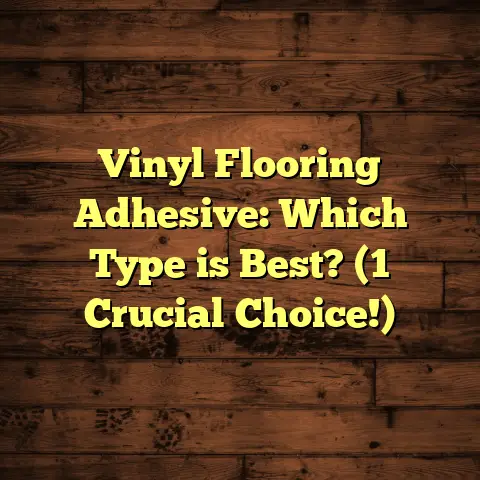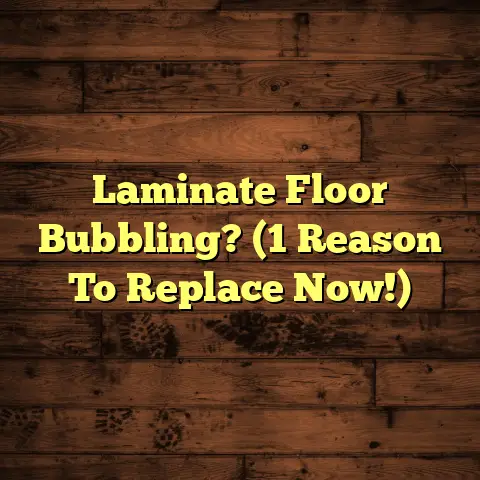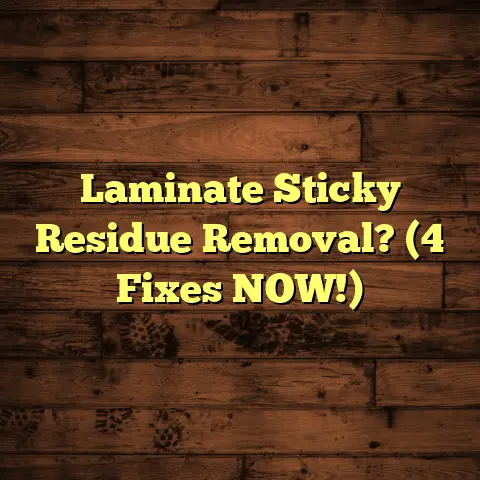Bleach Parquet Flooring? (1 Pro Tip!)
In a world where cleanliness is synonymous with perfection, the act of introducing bleach—a substance renowned for its harsh properties—into the delicate artistry of parquet flooring seems counterintuitive.
How can something that destroys bacteria and stains possibly be a friend to the intricate designs of wood? Let’s dive in!
The Allure of Parquet Flooring
Parquet flooring. Just the name conjures images of elegance and sophistication, right?
I’ve installed countless floors in my career, and let me tell you, parquet has a timeless appeal that few other materials can match.
It’s basically a geometric mosaic made of wood, creating stunning patterns like herringbone, chevron, or even more intricate custom designs. Think of it as art underfoot.
A Little History
Parquet flooring isn’t new. It’s been around for centuries! Its origins can be traced back to 17th century France. Imagine that!
They were looking for a cost-effective alternative to marble floors found in Versailles, and what they came up with was this beautiful wood mosaic.
Over time, the techniques evolved, and parquet became more accessible, finding its way into homes and commercial spaces worldwide. It’s a testament to enduring design.
Unique Patterns and Designs
What I love most about parquet is its versatility. You’re not just stuck with straight planks. You can create truly unique designs that reflect your personal style. Herringbone is a classic, of course.
But you can also do chevron, basket weave, or even custom patterns. I had a client once who wanted a parquet floor that mimicked the design of a Persian rug.
It was a challenge, but the result was absolutely breathtaking. That’s the magic of parquet. It’s more than just a floor. It’s a statement.
Understanding Bleach in the Context
of Cleaning
Okay, let’s switch gears and talk about bleach. We all know it. We all (probably) use it. But do we really understand it?
Bleach is a powerful chemical compound used for disinfecting and whitening. It’s like the superhero of the cleaning world.
But like any superhero, it has its weaknesses and kryptonite.
What Is Bleach?
At its core, bleach is a solution of sodium hypochlorite (NaClO) in water. That’s chlorine bleach. There’s also oxygen bleach, which uses hydrogen peroxide or other peroxygen compounds.
Chlorine bleach is stronger and more effective for disinfecting, while oxygen bleach is gentler and better for stain removal. I see you nodding. Yep, need to keep up!
Common Uses of Bleach
Bleach is used in a wide range of cleaning applications. We’re talking laundry, bathroom cleaning, disinfecting surfaces, and even water treatment.
It’s effective against bacteria, viruses, and fungi, making it a go-to for killing germs. But here’s the thing: its strength is also its potential downfall.
Proper Cleaning Methods
Maintaining the integrity of your flooring, regardless of the material, requires proper cleaning methods. This means using the right products, the right techniques, and the right frequency.
Over-cleaning or using harsh chemicals can do more harm than good. I’ve seen it time and time again. Remember, gentle is often better.
The Relationship Between Bleach and
Parquet Flooring
Now, let’s get to the heart of the matter: bleach and parquet flooring. Can they coexist? Should they ever coexist?
The short answer is: it’s complicated. But let’s break it down.
Concerns About Using Bleach on Wood
Wood is a natural material. It’s porous and susceptible to damage from harsh chemicals. Bleach, being a strong oxidizing agent, can wreak havoc on wooden surfaces.
It can strip the finish, fade the color, and even weaken the wood fibers themselves. Imagine pouring acid on a delicate painting. That’s kind of what bleach does to parquet.
How Bleach Affects Parquet
When bleach comes into contact with parquet flooring, several things can happen. The finish can become dull or discolored.
The wood can lighten unevenly, creating unsightly patches. In severe cases, the bleach can penetrate deep into the wood, causing structural damage.
I’ve seen floors where the bleach has literally eaten away at the wood, leaving it brittle and crumbly. It’s not a pretty sight, trust me.
When Bleach Might Be Beneficial
(and When It’s Harmful)
Okay, I’m not going to say that bleach is always a no-go for parquet. There might be situations where a very diluted bleach solution could be used to address a specific issue, like a stubborn stain or mold growth.
But, and this is a big but, it should only be done as a last resort and with extreme caution. The risks almost always outweigh the benefits.
The Pro Tip: How to Use Bleach Safely on
Parquet Flooring
Alright, here’s the pro tip I promised:
When using bleach on parquet flooring, always dilute it with water and test it in an inconspicuous area first.
It sounds simple, but it’s crucial.
The Science Behind Dilution
Dilution is the key to minimizing the harmful effects of bleach. By diluting the bleach with water, you reduce its concentration and oxidizing power.
This makes it less likely to damage the finish or the wood itself. Think of it like watering down a strong drink. It’s still there, but it’s not as potent.
Step-by-Step Guide to Preparing the
Bleach Solution
- Gather your supplies: You’ll need bleach, water, a measuring cup, a bucket, a sponge or mop, and safety gloves.
- Choose the right ratio: A good starting point is 1 part bleach to 10 parts water. For tougher stains, you can try a slightly stronger solution, but never exceed 1 part bleach to 5 parts water.
- Mix the solution: Pour the water into the bucket first, then add the bleach. This helps prevent splashing and ensures proper mixing.
- Test in an inconspicuous area: Before applying the solution to the entire floor, test it in a hidden spot, like under a piece of furniture or in a closet. Wait at least 24 hours to see if there are any adverse effects.
- Apply the solution: If the test area looks good, use a sponge or mop to apply the solution to the stained area. Avoid saturating the wood.
- Rinse and dry: After a few minutes, rinse the area with clean water and dry it thoroughly with a clean cloth.
Alternative Cleaning Solutions for
Parquet Flooring
Let’s be honest, there are much safer and more effective ways to clean parquet flooring than using bleach.
Why risk damaging your beautiful floor when there are so many great alternatives?
Natural Cleaning Solutions
Vinegar is a fantastic natural cleaner. Mix a 1/2 cup of white vinegar with a gallon of warm water, and you have a gentle yet effective cleaning solution.
Mild soap is another good option. Just make sure to use a pH-neutral soap specifically designed for wood floors. Avoid harsh detergents or abrasive cleaners.
Regular Maintenance and Care
The best way to keep your parquet flooring looking its best is to practice regular maintenance. Sweep or vacuum regularly to remove dirt and debris.
Use a damp mop (not soaking wet) to clean the floor as needed. Avoid using excessive water, as this can damage the wood.
Real-Life Experiences and Case Studies
I’ve seen firsthand the good, the bad, and the ugly when it comes to cleaning parquet flooring. Let me share a few stories.
The Good
I had a client who accidentally spilled red wine on her parquet floor. She immediately blotted up the spill and then used a diluted vinegar solution to clean the area.
The stain came out completely, and the floor looked as good as new. Quick action and a gentle cleaner saved the day.
The Bad
Another client decided to use bleach to clean a moldy area in her bathroom. She didn’t dilute the bleach properly, and it ended up stripping the finish and discoloring the wood.
She had to hire a professional to refinish the entire floor, which cost her a small fortune. A costly mistake!
Lessons Learned
The key takeaway from these experiences is that prevention is always better than cure. Avoid using harsh chemicals on your parquet flooring, and always test any cleaning solution in an inconspicuous area first.
DIY vs. Professional Cleaning Services
Should you tackle parquet floor cleaning yourself, or should you hire a professional? Let’s weigh the pros and cons.
Pros and Cons of DIY Cleaning
DIY cleaning can save you money, and it gives you control over the cleaning process. But it also comes with risks.
If you’re not careful, you could damage your floor. Plus, it can be time-consuming and labor-intensive.
When to Seek Professional Help
If you have high-end or antique parquet flooring, it’s best to leave the cleaning to the professionals. They have the expertise, the equipment, and the products to clean your floor safely and effectively.
Cost Implications
Professional cleaning services can be expensive, but they can also save you money in the long run by preventing damage to your floor. Think of it as an investment in the longevity of your beautiful parquet.
Conclusion
So, there you have it. Bleach and parquet flooring: a complicated relationship. While bleach can be a powerful cleaning agent, it’s generally not the best choice for parquet.
The pro tip I shared—always dilute bleach and test it in an inconspicuous area—is crucial if you decide to use it. But honestly, there are safer and more effective alternatives out there.
Remember the paradox we started with? The balance between cleanliness and preservation. Parquet flooring is a work of art.
Treat it with care, and it will reward you with its beauty and elegance for years to come. Make informed decisions about your flooring care, and enjoy the enduring charm of parquet.




